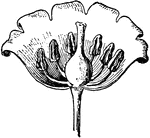Clipart tagged: ‘Lily of the Valley’

Lily of the Valley
A genus of plants of the family liliaceae, native to the bushy places of America and Eurasia. It has…

Lily of the Valley
Convallaria majalis, commonly known as the Lily of the Valley or Lily-of-the-Valley, is the only species…

Lily of the Valley
Also known as Convallaria majalis. It is native throughout the Northern Hemisphere in Asia and Europe.…

Crowns of the Lily of the Valley
The three sizes of crowns represent the crowns aged at one, two, and three years.

Flowering Stem of the Lily of the Valley
Size and good quality in the flowers of the Lily of the Valley depend upon the cultivation and attention…

Young Crown of the Lily of the Valley
The method for propagating the lily of the valley is by the numerous crowns which form at the points…

M. Canadense and C. Majalis
Two species of the lily family (Liliaceae): left, Canada Mayflower (Maianthemum canadense); right, lily…

Section of Lily-of-the-Valley
Illustrated is a section of the flower of lily-of-the-valley. It is laid open to show the parts.

Canada Mayflower
An illustration of flowering plant of the Canadian mayflower, flower (a), and fruit (b). Maianthemum…

